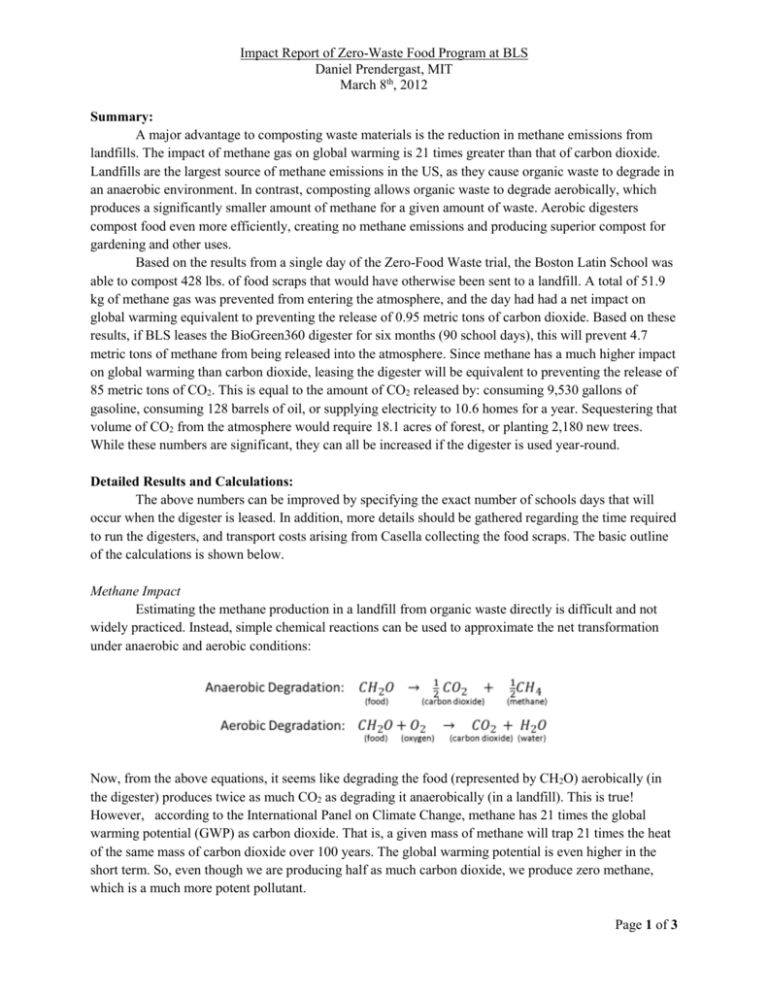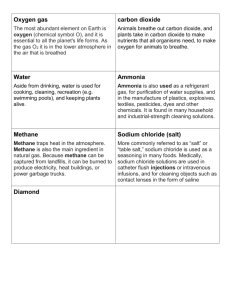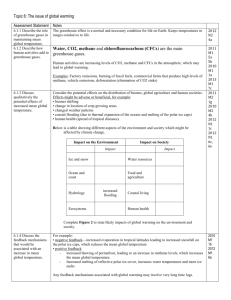Composting_files/Zero-Food Waste Impact Report
advertisement

Impact Report of Zero-Waste Food Program at BLS Daniel Prendergast, MIT March 8th, 2012 Summary: A major advantage to composting waste materials is the reduction in methane emissions from landfills. The impact of methane gas on global warming is 21 times greater than that of carbon dioxide. Landfills are the largest source of methane emissions in the US, as they cause organic waste to degrade in an anaerobic environment. In contrast, composting allows organic waste to degrade aerobically, which produces a significantly smaller amount of methane for a given amount of waste. Aerobic digesters compost food even more efficiently, creating no methane emissions and producing superior compost for gardening and other uses. Based on the results from a single day of the Zero-Food Waste trial, the Boston Latin School was able to compost 428 lbs. of food scraps that would have otherwise been sent to a landfill. A total of 51.9 kg of methane gas was prevented from entering the atmosphere, and the day had had a net impact on global warming equivalent to preventing the release of 0.95 metric tons of carbon dioxide. Based on these results, if BLS leases the BioGreen360 digester for six months (90 school days), this will prevent 4.7 metric tons of methane from being released into the atmosphere. Since methane has a much higher impact on global warming than carbon dioxide, leasing the digester will be equivalent to preventing the release of 85 metric tons of CO2. This is equal to the amount of CO2 released by: consuming 9,530 gallons of gasoline, consuming 128 barrels of oil, or supplying electricity to 10.6 homes for a year. Sequestering that volume of CO2 from the atmosphere would require 18.1 acres of forest, or planting 2,180 new trees. While these numbers are significant, they can all be increased if the digester is used year-round. Detailed Results and Calculations: The above numbers can be improved by specifying the exact number of schools days that will occur when the digester is leased. In addition, more details should be gathered regarding the time required to run the digesters, and transport costs arising from Casella collecting the food scraps. The basic outline of the calculations is shown below. Methane Impact Estimating the methane production in a landfill from organic waste directly is difficult and not widely practiced. Instead, simple chemical reactions can be used to approximate the net transformation under anaerobic and aerobic conditions: Now, from the above equations, it seems like degrading the food (represented by CH2O) aerobically (in the digester) produces twice as much CO2 as degrading it anaerobically (in a landfill). This is true! However, according to the International Panel on Climate Change, methane has 21 times the global warming potential (GWP) as carbon dioxide. That is, a given mass of methane will trap 21 times the heat of the same mass of carbon dioxide over 100 years. The global warming potential is even higher in the short term. So, even though we are producing half as much carbon dioxide, we produce zero methane, which is a much more potent pollutant. Page 1 of 3 Impact Report of Zero-Waste Food Program at BLS Daniel Prendergast, MIT March 8th, 2012 To fully calculate the impact of using a digester, we must first calculate the amount of methane that was not produced, using the anaerobic equation above. Thus, by measuring the weight of food scraps landfilled, the calculation proceeds as: 428 𝑙𝑏𝑠 × 1000 𝑔 𝑚𝑜𝑙𝐶𝐻2 𝑂 1 𝑚𝑜𝑙𝐶𝐻4 16 𝑔 𝑘𝑔 × × × × = 51.8 𝑘𝑔 𝑜𝑓 𝐶𝐻4 2.2 𝑙𝑏 30 𝑔 2 𝑚𝑜𝑙𝐶𝐻2 𝑂 𝑚𝑜𝑙𝐶𝐻4 1000 𝑔 The impact of various chemical emissions on global warming is commonly expressed as an equivalent mass of carbon dioxide (kg CO2 eq.). This is done by multiplying the mass of the chemical (in this case methane) by its GWP: 51.8 𝑘𝑔 𝑜𝑓 𝐶𝐻4 × 21 𝑘𝑔 𝐶𝑂2 = 1090 𝑘𝑔 = 1.09 𝑚𝑒𝑡𝑟𝑖𝑐 𝑡𝑜𝑛𝑠 𝑜𝑓 𝐶𝑂2 1 𝑘𝑔 𝐶𝐻4 So, the methane not produced by the food scraps is equivalent to preventing the release of 1.1 tons of CO2. Now, we just have to subtract off the actual amount of CO2 produced by the aerobic reaction to find our net savings. The calculation is similar to that performed above, and the results are tabulated below: Table 1: Emissions savings from one day of Zero-Waste Food Program CO2 produced Methane Produced Global Warming Impact (kg) (kg) (kg CO2 eq.) Landfill 142 51.8 1230 Digester 285 0 285 LANDFILL - DIGESTER = SAVINGS = 945 Thus, in a single day the Zero-Waste Food Program prevented an equivalent of 0.95 metric tons of CO2 from entering the atmosphere, in terms of global warming potential. This impact can further be converted into more meaningful values, including gallons of gasoline burned, vehicle emissions, etc. The EPA has an excellent online calculator for doing these conversions: http://www.epa.gov/cleanenergy/energy-resources/calculator.html. Of course, these results are only from one day. Scaling the impact over the course of six months or a year can be done by simply multiplying any of the above results by the number of days the digester is used. Table 2 below showcases some of these results: Page 2 of 3 Impact Report of Zero-Waste Food Program at BLS Daniel Prendergast, MIT March 8th, 2012 Table 2: Results from scaling the impact from one day of the Zero-Waste Food Program 1 day 90 days 180 days Methane Emissions 51.8 4,659 9,319 Prevented (kg) Equivalent CO2 Emissions 0.95 85 170 (metric tons) Equivalent Consumption 106 9,500 19,000 of Gasoline (gal) Page 3 of 3








